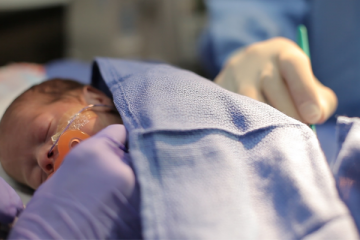CPAM Diagnosis, Causes, & Treatments
How is CPAM diagnosed?
With improvement in prenatal imaging technology, most CPAMs are detected during a routine prenatal ultrasound. A fetal MRI or fetal echocardiogram may also be used to confirm the diagnosis. Learn more about fetal MRIs and fetal echocardiograms at CHOC.
During pregnancy, CPAMs typically increase in size throughout the second trimester. Then, in the third trimester, they usually start to shrink in size. Your baby’s doctor will pay close attention to see if this happens. Most babies will be carried to term and have normal development and lung function at birth. In rare cases where a CPAM grows so large it cause distress to your unborn baby, the specialists at The Fetal Care of Southern California can help.
If your baby has been diagnosed with CPAM in the prenatal period, we would be happy to schedule a consultation with your family and one of our top pediatric surgeons, as well as a CHOC neonatologist and your perinatologist, to prepare for the birth and subsequent care of your baby. If your child has been diagnosed with CPAM after delivery, we’d recommend scheduling a consultation with your family and one of our pediatric surgeons.
What causes a Congenital Pulmonary Airway Malformation (CPAM)?
The cause of a CPAM is unknown, and it is not related to anything the mother did or did not do during the pregnancy. CPAM used to be named congenital cystic adenomatoid malformation (CCAM).What is the difference between a Congenital Pulmonary Airway Malformation (CPAM) and a Congenital Cystic Adenomatoid Malformation (CCAM)?
CPAM is the new term for abnormal cystic tissue in the lung. It has replaced the older them CCAM.How is CPAM treated?
Most babies with a small CPAM are born with no symptoms and can go home after a few days in the hospital. Surgery to remove the CPAM is usually performed when a baby is two to six months old. Surgery is performed to prevent potentially severe infections related to the CPAM tissue. It is also done to prevent the rare lung cancer that can develop much later in life in CPAM tissue that has not been removed.
Although it is very rare, sometimes a CPAM can grow so large in the prenatal period as to cause heart failure and swelling of the body in a fetus. This condition is called hydrops. When a CPAM is this large, it can also prevent the fetus’ lungs from fully developing, leading to pulmonary hypoplasia, or small lungs. In these very rare cases, the fetus may benefit from prenatal interventions which can include treatment with steroids, drainage of a fluid filled CPAM cyst, or even surgery in the womb to remove the CPAM tissue.
Your perinatologist, a specialist in fetal and maternal medicine, will discuss your delivery plans. Your baby should be born at a hospital with close access to a neonatal intensive care unit (NICU) that has extracorporeal membrane oxygenation (ECMO) available, which will help your baby’s heart and lungs function if the condition is severe. The CHOC NICU is designated a Level 4 NICU—the highest level available because of the complex conditions we treat—and we are the only hospital in Orange County to provide ECMO for children. Learn more about our NICU.


 When it comes to surgery, babies present a unique challenge because of their small size and complex conditions. Their health can change in an instant, requiring quick action and expertise.
When it comes to surgery, babies present a unique challenge because of their small size and complex conditions. Their health can change in an instant, requiring quick action and expertise.

























